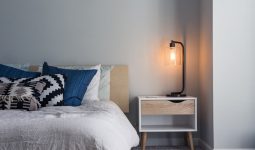Everyone loves a room with a sense of warmth and elegance. Wainscoting is popular because it adds visual depth to a home and makes it more beautiful.
However, there are different types of wainscoting depending on the style you want. Do you want to know more? Read on.
What is Wainscoting?
Wainscoting is a type of wood paneling popular in the late 18th century and early 19th century. It is usually applied to the lower portion of an interior wall in a home.
It became so popular because it provides a durable finish and also adds warmth to the room.
In the past, wainscoting was primarily used in public buildings, including schools, churches, and government offices.
However, wainscoting has become popular for homeowners who want to add a unique touch to their homes. Many modern houses feature wainscoting in the kitchen, bathrooms, and even bedrooms.
Wainscoting comes in various styles, colors, textures, and materials. It is mostly made of solid wood, plywood, medium-density fiberboard, and plastic. In addition, it can be easily removed and replaced if necessary.
However, wainscoting may not be suitable for certain types of rooms. For example, if the room is small, wainscoting might make the space cramped.
If you plan to install wainscoting in a room with a lot of furniture, you may need to remove some of the existing items before you do so.
The Parts of a Wainscot
Wainscoting typically consists of five components that make up its appearance.
Depending on the sophistication of the style, additional components may be included.
But all wainscoting has a Lower Rail, Upper Rail, Bottom Cap, Top Cap, and Shoe.
You can add the additional components in the center with raised panels, flat panels, beadboard panels, overlays, and shiplap boards, which comprise the different types of wainscoting.
Wainscoting Tools
Wainscoting tools create a decorative finish around the base of windows and doors. There are many different types of wainscoting tools available; they include:
- Jointing Knife—A jointing knife is a tool for cutting joints between pieces of drywall. It is similar to a utility knife, but it cuts drywall instead of paper.
- Spackle – Spackle is a plaster that fills holes and cracks in drywall.
- Sandpaper—Sandpaper can be used to apply smooth surfaces. It is commonly used to remove any rough edges left behind after sanding.
- Wood Router—A router is a powerful tool for shaping wood. It uses a bit that spins at high speeds while attached to a drill motor. The router cuts grooves, holes, and decorative features into the wood.
- Wood Chisels – Wood chisels carve out small designs into wood. You can only use them for detailed work and not for heavy-duty tasks.
- Jigsaw—A jigsaw is a hand-held power tool that uses a spinning blade to cut pieces of wood. It is versatile and can be used to carve intricate details into wood.
- Screwdrivers – Screwdrivers tighten screws that hold down the wallboard. A typical screwdriver has a handle and a blade at the end. The blade is sharpened to cut the threads of the screw head.
- Nails – Nails attach the wallboard to the floor joists. The wallboard comes with pre-drilled holes that accept nails.
- Hammers—Hammerheads drive nails into the wallboard. They are either claw or ball-shaped. Claw hammers drive long nails, while ball hammers are for short nails.
- Tape Measures—Tape measures measure the length of the wallboard. They have retractable tape wound around a spool.
Different Types of Wainscoting
1. Raised Panel Wainscoting
Raised panel wainscoting first gained popularity in England in the 17th century to insulate homes.
This type of wainscoting is the oldest and most prevalent. You can find them in colonial-type homes, especially in their living and dining rooms.
The placement of the panels in front of the rails and stiles makes raised panel wainscoting distinct.
The finished design results in panels that appear elevated off the wall.
Also, adding bevels to the edges results in a three-dimensional surface with a more excellent texture and a more formal appearance.
2. Flat Panel Wainscoting
A flat panel is one of the different types of wainscoting. It features panels that are set behind the stiles and rails.
This form of wainscoting has a modern appearance because it uses boards without beveled edges or molding, which makes them appear more profound than the stiles and rails.
The only decorative element of flat paneling is the seams separating each board; otherwise, it is smooth on the front and lacks any bevels, beads, or grooves.
Sometimes, these seams are usually exposed or covered with metal or wood strips.
Flat panel wainscoting is a type of wall covering that has become very popular over the last few years. They are often installed in kitchens, bathrooms, hallways, bedrooms, and living rooms.
3. Beadboard Wainscoting
Beadboard wainscoting is a type of wall covering consisting of small wooden strips nailed to the wall, forming a grid pattern.
It is often made of wood planks nailed together to create a decorative look.
In modern times, beadboard wainscoting is becoming popular for homeowners who want to add some character to their homes without spending much money.
Beadboard wainscoting, also known as beadboard paneling, is a great way to add warmth and character to a room without breaking the bank.
When the pieces of wood are fastened together, they form a bead between them.
4. Board & Batten Wainscoting
Board and batten is a form of flat panel wainscoting that uses vertical boards to conceal the seams or styles.
It is distinctive in style thanks to its consistent pattern of broad vertical molding boards, also called battens.
These battens are often set 6 to 10 inches apart and 4 to 6 inches wide. They hide the joint between boards; you can also add extra battens between the joints for aesthetic purposes.
Board and batten wainscoting has a stark appearance and was highly favored in 20th-century homes.
Meanwhile, this wainscoting style has recently become more popular due to its seamless appearance and clean lines.
5. Overlay Wainscoting
Overlay Wainscoting is wood paneling you put over an existing wallboard or plaster.
The panels are usually made from plywood, particle board, medium-density fiberboard (MDF), or oriented strand board (OSB).
Overlay wainscoting is often used to cover walls with damaged drywall or wallpaper or where the original finish is no longer attractive.
Installing overlay wainscottings takes about 10 hours. However, if you hire someone to help you, you can get it done much faster.
You can find overlay wainscoting at home improvement stores and websites that sell wainscoting materials.
This wainscoting style adds a unique look to a room without being too busy.
7 Advantages of Adding Wainscoting to Your Home
- Aesthetics – Wainscoting adds a beautiful look to any room. You don’t need to worry about painting the walls since they already match the color of the wood.
- Durability—Wainscoting provides a durable surface that is resistant to moisture and stains. It is also simple to maintain and clean.
- Easy Installation – Wainscoting may seem difficult, but DIY wainscoting is a good approach for beginners.
- Versatility—Wainscoting can be installed in almost any room in your house, including bathrooms, kitchens, and garages.
- Cost-effective—Wainscoting requires little maintenance and can last for years. It is also cheap and simple to install.
- Style and elegance – Wainscoting adds style and elegance to any room. You can choose between different colors, styles, and textures.
- Warmth—Wainscoting creates a warm atmosphere. It helps regulate temperature and keeps rooms cool in summer and warm in winter.
Conclusion
If you’re considering designing your home with one, there are different types of wainscoting to choose from.
However, ensure that you don’t install them poorly because this may lead to deformation and flexing of the panels.
Hiring a professional is better if you can’t do it yourself. Thanks for reading!








